
|
You entered: Fire
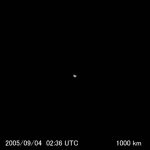 Approaching Asteroid Itokawa
Approaching Asteroid Itokawa
19.09.2005
What are asteroids made of? To help find out, Japan's JAXA space agency launched the Hayabusa mission to rendezvous with asteroid Itokawa. Last week, the small robotic Hayabusa spacecraft arrived at asteroid Itokawa and stationed itself only 20 kilometers away.
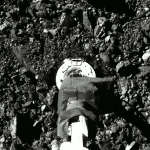 Tagging Bennu
Tagging Bennu
21.09.2023
The OSIRIS-REx spacecraft's arm reached out and touched asteroid 101955 Bennu on October 20, 2020, after a careful approach to the small, near-Earth asteroid's boulder-strewn surface. Dubbed a Touch-And-Go (TAG) sampling event...
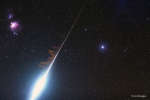 A Blazing Fireball between the Orion Nebula and Rigel
A Blazing Fireball between the Orion Nebula and Rigel
16.11.2015
What's happening to that meteor? A few days ago, a bright fireball was photographed from the Alps mountain range in Switzerland as it blazed across the sky. The fireball, likely from the Taurids...
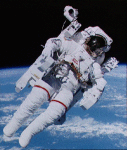 Floating Free in Space
Floating Free in Space
11.10.1997
NASA astronauts can float free in space without any connection to a spaceship. Here astronaut Bruce McCandless maneuvers outside the Space Shuttle Challenger by firing nitrogen gas thrusters on his manned maneuvering unit (MMU). This picture was taken in 1984 and records this first untethered spacewalk. The MMU was developed because astronauts found tethers restrictive.
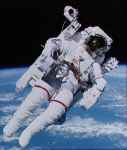 Floating Free in Space
Floating Free in Space
14.06.1996
NASA astronauts can float free in space without any connection to a spaceship. Here astronaut Bruce McCandless maneuvers outside the Space Shuttle Challenger by firing nitrogen gas thrusters on his manned maneuvering unit (MMU). This picture was taken in 1984 and records this first untethered spacewalk. The MMU was developed because astronauts found tethers restrictive.
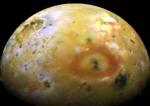 Io's Giant Volcano Pele
Io's Giant Volcano Pele
5.12.1996
Io has some very large volcanoes. One of the largest is evident near the center of the above photograph and named Pele, for the mythological Polynesian fire goddess. The Galileo spacecraft now orbiting Jupiter took this picture of Jupiter's most active moon in June, although it was released just last week.
 The United States At Night
The United States At Night
8.07.2000
This is what the United States of America looks like at night! Can you find your favorite US city in this image? Surprisingly, city lights make this task quite possible. The above picture is actually a composite of over 200 images made by satellites orbiting planet Earth.
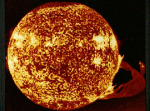 The Sun Erupts
The Sun Erupts
16.09.1996
The Sun is a seething ball of extremely hot gas. Above, the Sun was captured by Skylab in 1973 throwing off one the largest eruptive prominences in recorded history. The Sun has survived for about 5 billion years, and will likely survive for another 5 billion.
 Europe at Night
Europe at Night
16.05.1999
This is what Europe looks like at night! Can you find your favorite European city? Although not all of Europe is shown, city lights might make this task possible. The above picture is actually a composite of over 200 images made by satellites orbiting the Earth.
 The Sun Erupts
The Sun Erupts
30.08.1998
The Sun is a seething ball of extremely hot gas. Above, the Sun was captured by Skylab in 1973 throwing off one the largest eruptive prominences in recorded history. The Sun has survived for about 5 billion years, and will likely survive for another 5 billion.
|
January February March April May |
|||||||||||||||||||||||||||||||||||||||||||||||||